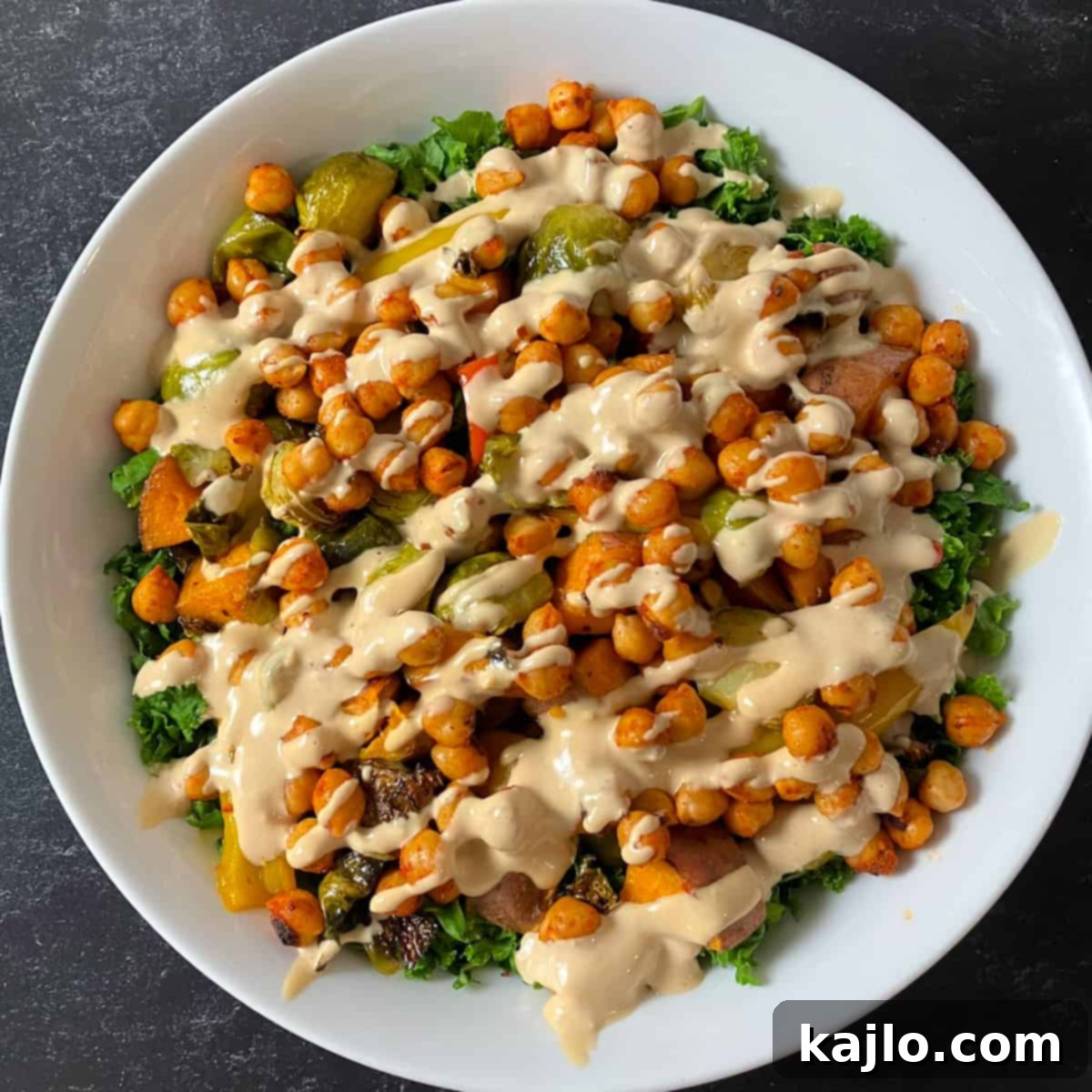Welcome to the ultimate guide for creating delicious, satisfying, and health-conscious meals that perfectly fit into your busy lifestyle. Discover the vibrant world of Low Calorie Nourish Bowls – a versatile and fulfilling vegan meal solution brimming with lean protein and an abundance of non-starchy vegetables. These nutrient-packed bowls are designed not just to tantalize your taste buds but also to support your health and wellness goals, whether you’re aiming for weight management, increased energy, or simply a more plant-forward diet.
Our featured Nourishing Bowl recipe incorporates a symphony of wholesome ingredients: fresh kale, perfectly roasted Brussels sprouts, tender sweet potatoes, colorful bell peppers, and smoky roasted chickpeas. Each component is carefully chosen to provide a wealth of nutrients and a delightful variety of textures. The grand finale is our signature Nourish Bowl Dressing, a luxuriously creamy tahini sauce that ties all the flavors together, transforming these ingredients into a hearty and satisfying vegetarian meal prep dream. We’ll also share expert tips to easily adapt these under 500-calorie power bowls to be low carb and gluten-free, ensuring everyone can enjoy their nourishing goodness!
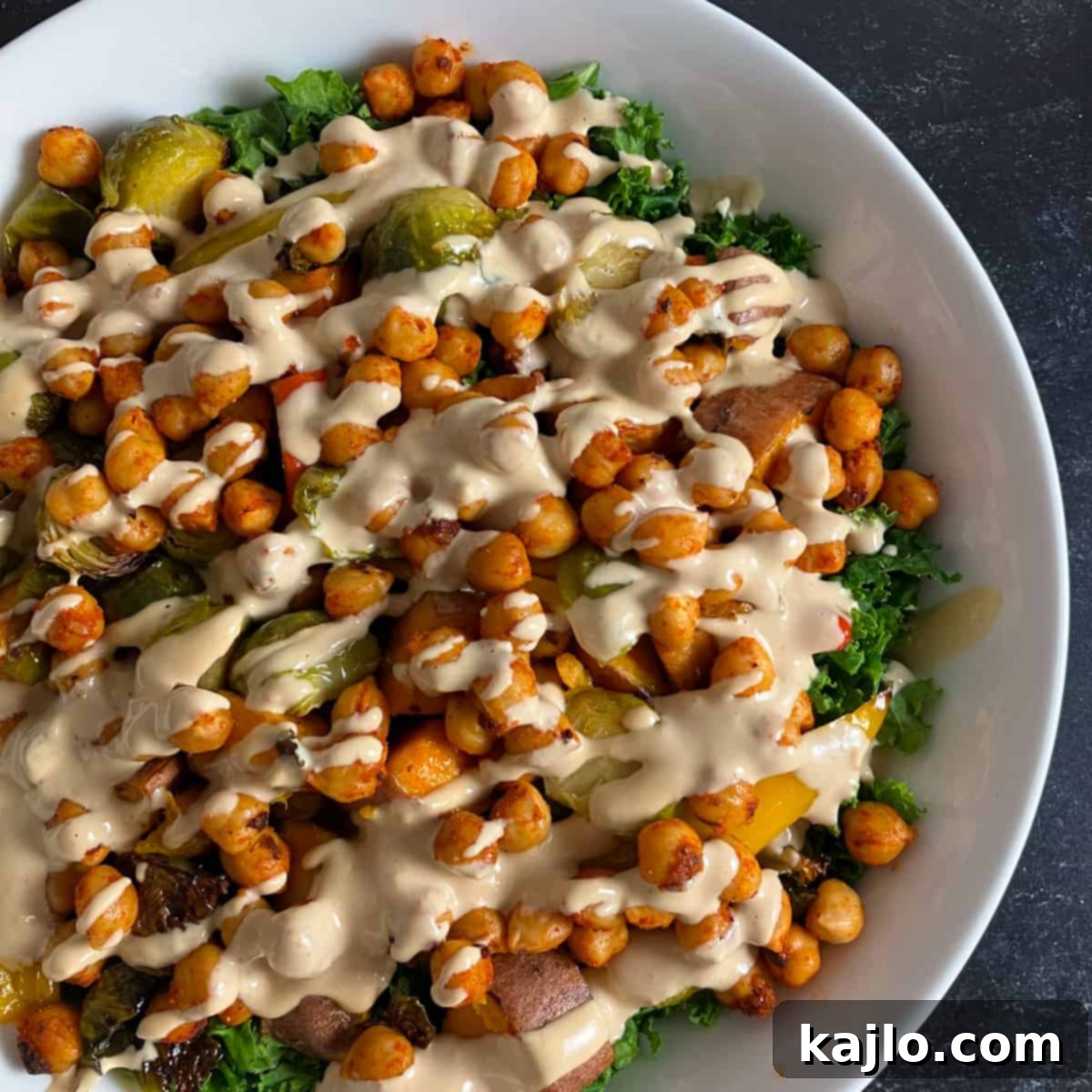
🥗 Crafting the Perfect Low Calorie Nourish Bowl
Nourish bowls, sometimes called Buddha bowls or power bowls, are celebrated for their incredible flexibility and customizable nature. They embody a balanced approach to eating, much like the MyPlate concept, allowing you to build a meal that perfectly suits your dietary needs and preferences. The beauty of these bowls lies in their simple formula, which makes healthy eating effortless and enjoyable. Let’s dive into the essential components that make up a truly exceptional nourish bowl:
- Vibrant Vegetables: The Foundation of Flavor and Nutrients
For our low-calorie vegan nourish bowls, we start with a generous medley of roasted vegetables. For four servings, consider roasting two medium sweet potatoes (about 10 ounces), one pound of Brussels sprouts, one red bell pepper, and one yellow bell pepper, all tossed lightly in just one tablespoon of olive oil. Roasting brings out their natural sweetness and creates a tender-crisp texture. Sweet potatoes offer complex carbohydrates and a rich source of vitamins A and C, while Brussels sprouts are packed with fiber and vitamin K. Bell peppers add a burst of color and provide potent antioxidants. To create a low-carb vegan nourish bowl, simply swap the sweet potatoes for cauliflower or broccoli florets. If you’re not strictly vegan, grilled chicken breast or steak strips can replace chickpeas to meet your protein needs. - Protein Powerhouse: Keeping You Full and Energized
No nourish bowl is complete without a robust source of protein to promote satiety and support muscle health. Our recipe features two cans of drained chickpeas, gently warmed on the stovetop and seasoned with a flavorful blend of 2 teaspoons of smoked paprika, ½ teaspoon of onion powder, and ½ teaspoon of garlic powder. Chickpeas are an excellent plant-based protein source, rich in fiber, and contribute to the hearty texture of the bowl. For those seeking alternative high-protein options, consider adding sliced, grilled chicken breast, thin strips of grilled steak, air fryer tofu, smoked tofu, edamame, or tempeh. The key is to choose a protein that you enjoy and that aligns with your dietary goals. - Healthy Fats: Essential for Satiety and Nutrient Absorption
Healthy fats are crucial for a well-rounded meal, contributing to satiety and aiding in the absorption of fat-soluble vitamins. In this nourish bowl recipe, healthy fats come from multiple delicious sources. We roast our vegetables in olive oil, a heart-healthy monounsaturated fat. Additionally, our creamy tahini dressing, made from ground sesame seeds, provides a significant amount of healthy fats, along with essential minerals like calcium and magnesium. These fats ensure your meal is not only satisfying but also optimizes nutrient uptake from the vibrant vegetables. - Wholesome Base: The Canvas for Your Bowl
While many nourish bowls use whole grains like quinoa, brown rice, or wild rice as a base, we opt for a low-calorie, nutrient-dense alternative to keep these bowls under 500 calories. A base of 10 ounces of massaged kale provides ample healthy carbohydrates from the sweet potatoes and chickpeas. Massaging kale softens its texture and enhances its digestibility, making it a delightful, leafy foundation. Other excellent low-carb base options include cauliflower rice, crisp lettuce, fresh spinach, zucchini noodles (zoodles), or butternut squash noodles. Feel free to reintroduce whole grains if you prefer a higher-calorie, more energy-dense meal. - Texture & Crunch Toppings: Elevate Your Culinary Experience
Adding a variety of toppings is where nourish bowls truly shine, transforming them from a simple meal into an exciting culinary adventure. Beyond flavor, toppings provide essential texture and crunch, making each bite more interesting and satisfying. Consider scattering pomegranate arils for a sweet-tart burst, a sprinkle of nuts (like almonds or walnuts) or seeds (chia seeds, pumpkin seeds, sunflower seeds) for healthy fats and crunch. Nutritional yeast can add a cheesy, umami flavor, while a small amount of cheese (if not vegan) offers creaminess. Don’t forget your favorite seasonings and spices to further customize the flavor profile. Just remember that toppings will slightly alter the overall nutrition information. - Personalized Touches: Make It Uniquely Yours!
The beauty of a nourish bowl lies in its endless customization. Did we miss anything that would make your bowl perfect? Feel free to add a dollop of hummus for extra creaminess and protein, a spoonful of kimchi for a probiotic boost and tangy flavor, or fresh herbs like parsley, cilantro, or basil for aromatic brightness. Even fermented red cabbage sauerkraut can add a zesty, gut-friendly element. Don’t hesitate to experiment with your favorite healthy ingredients – the possibilities are truly limitless!
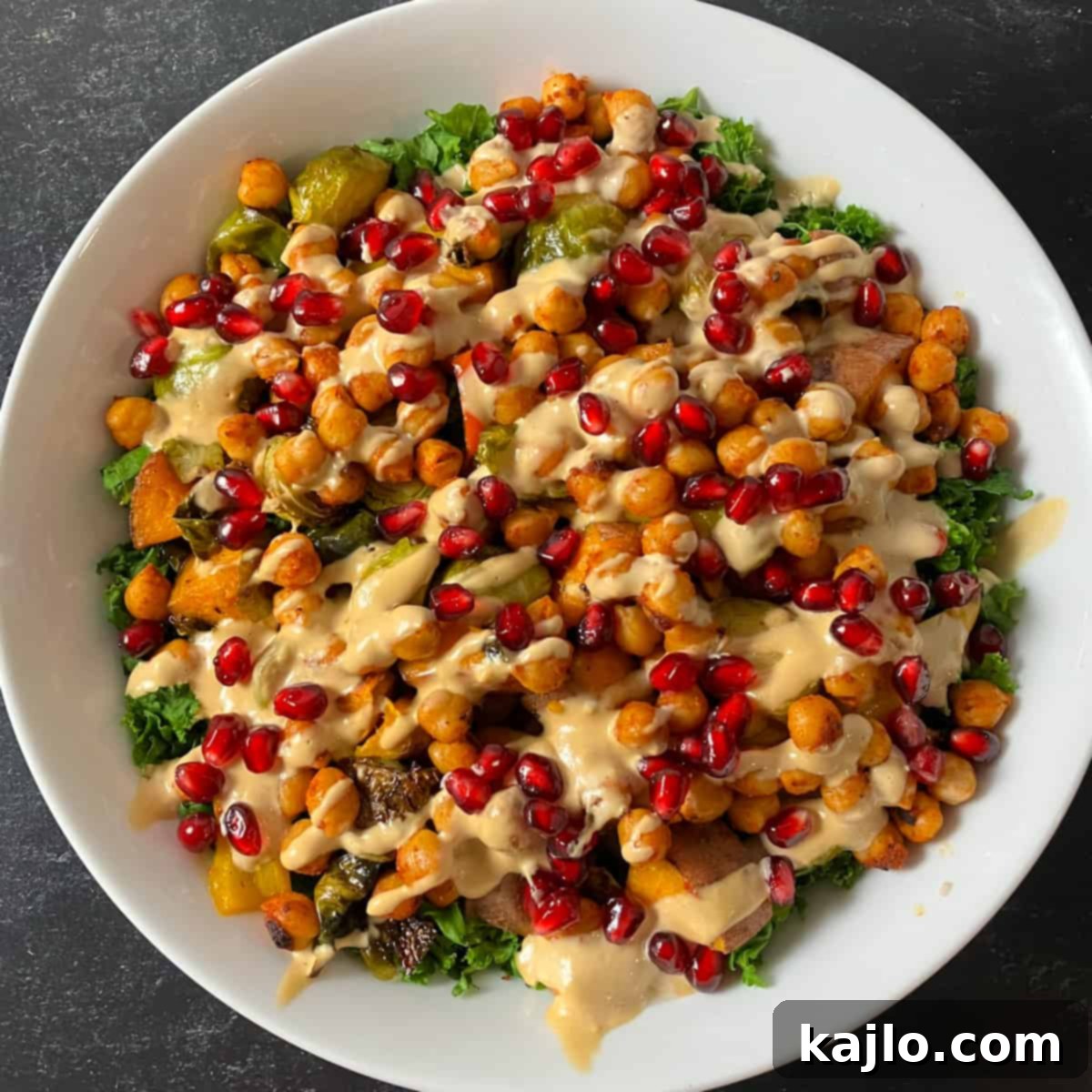
For detailed measurements and a printable version of this incredible recipe, scroll down to the end of this post where you’ll find our complete recipe card!
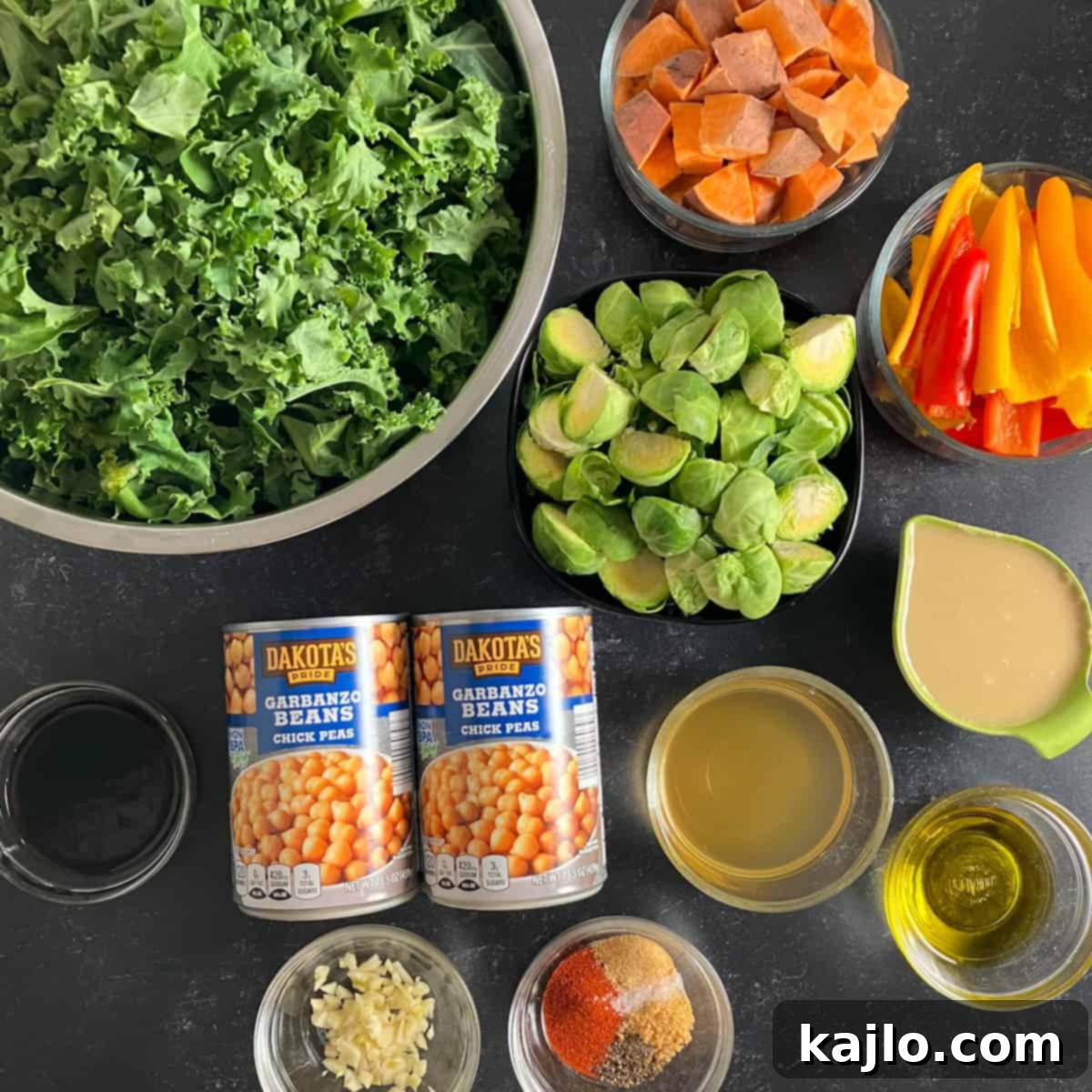
⭐ The Star of the Show: Our Creamy Tahini Nourish Bowl Dressing
A truly exceptional nourish bowl isn’t just about the fresh ingredients; it’s also about the dressing that brings everything together. Our homemade Nourish Bowl Dressing is a creamy, savory, and tangy tahini-based sauce that’s packed with plant-based healthy fats and a burst of flavor. It’s incredibly easy to make and elevates the entire dish, ensuring every bite is rich and satisfying. Here are the simple ingredients you’ll need to create this superfood sauce:
- ¼ cup tahini: The base of our creamy dressing, tahini is made from ground sesame seeds and is rich in healthy fats, protein, and minerals.
- 3 tablespoons apple cider vinegar: Adds a delightful tanginess and brightens the flavors.
- 2 tablespoons reduced-sodium soy sauce: Provides a deep umami flavor. Use tamari or coconut aminos for a gluten-free option.
- 1-2 cloves garlic: Fresh garlic adds a pungent, aromatic kick. Adjust to your preference.
- 1-2 tablespoons water: Used to adjust the consistency of the dressing to your liking.
To prepare this luscious dressing, simply combine all the ingredients in a mini food processor or blender. Blend for 1-2 minutes, or until the sauce is smooth and creamy. The dressing will naturally thicken as it sits, so if you’re making it ahead of time, you might need to add an extra splash of water before serving to achieve your desired consistency. Its nutty, tangy profile perfectly complements the roasted vegetables and savory chickpeas.
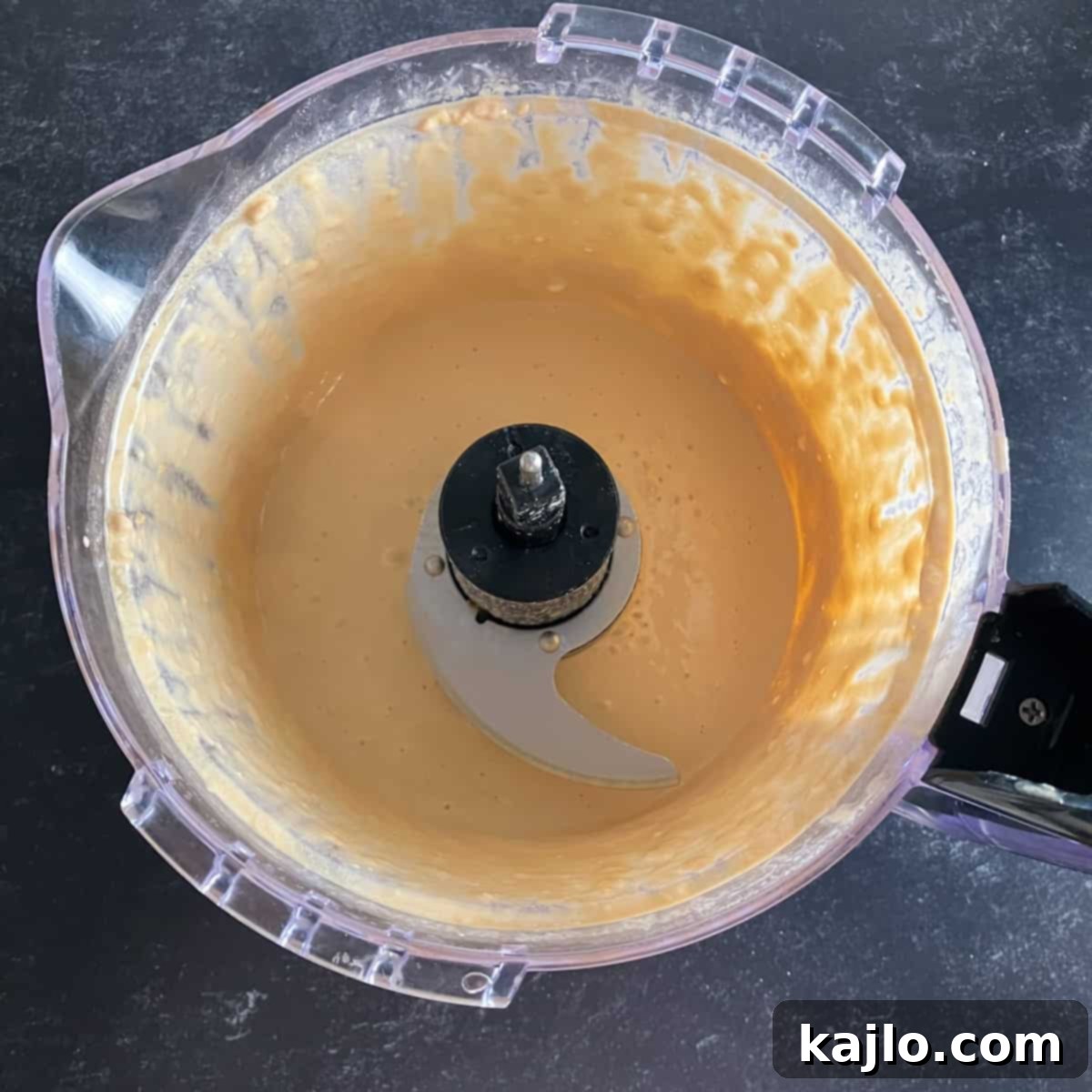
For those with dietary restrictions or simply looking to experiment, this dressing is highly adaptable. To make your nourish bowls gluten-free, effortlessly substitute the soy sauce with coconut aminos. If you prefer a brighter, zippier flavor, swap the apple cider vinegar for fresh lemon juice to create a vibrant lemon tahini sauce. Beyond tahini, other fantastic nourish bowl dressing ideas include a cooling tzatziki or another yogurt-based sauce, a herbaceous green goddess dressing, a rich keto pesto, thinned vegan chipotle mayo, classic BBQ sauce, fresh salsa, creamy guacamole, or even a zesty ranch dressing. The right dressing can truly transform your bowl!
➕ How to Assemble Your Healthy Nourish Bowls for Weight Loss
Creating these vibrant and healthy bowls for weight loss is a straightforward process, making them ideal for meal prep or a nutritious weeknight dinner. Follow these step-by-step instructions to bring your low-calorie nourish bowls to life:
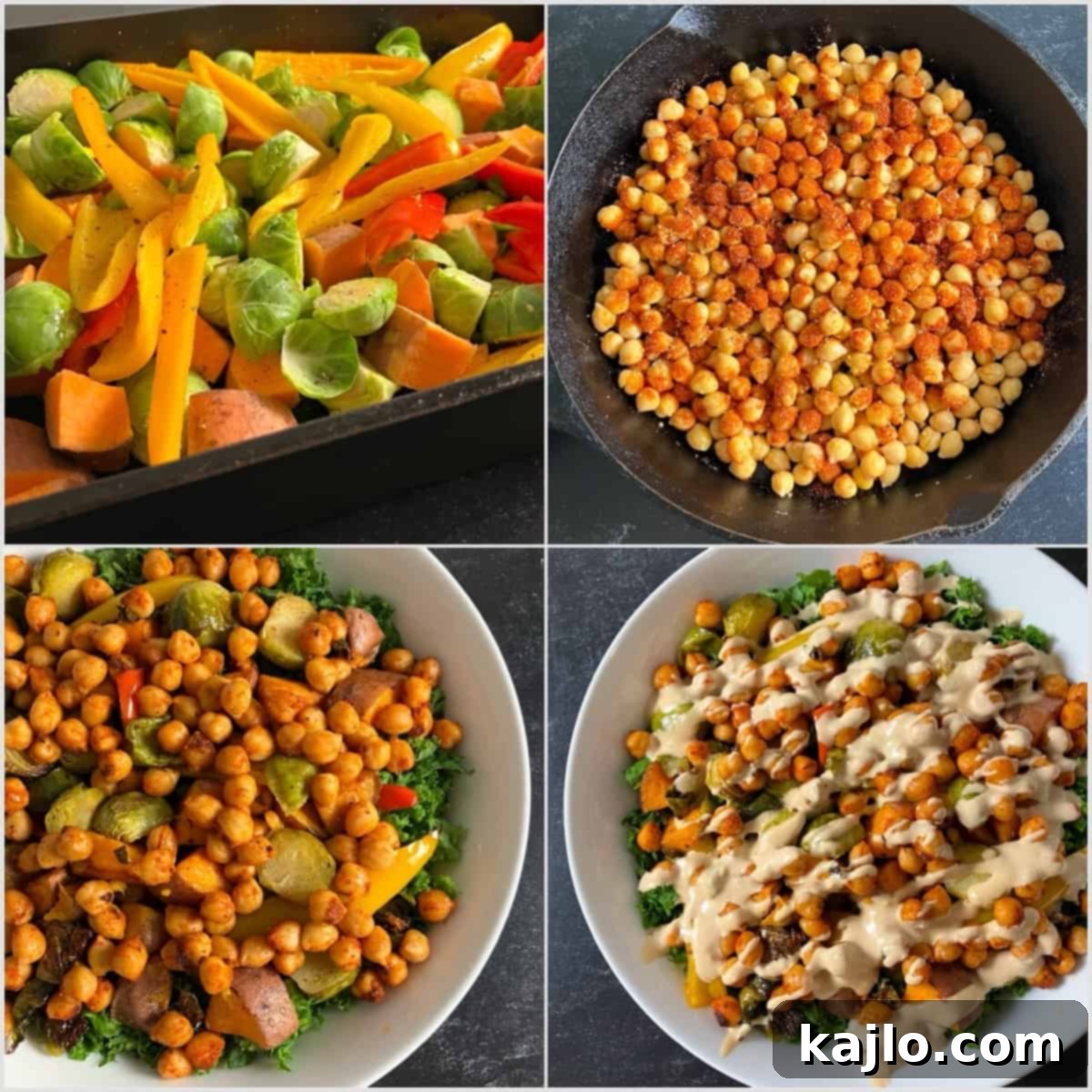
- Prepare Your Oven and Vegetables: Begin by preheating your oven to 400°F (200°C). While the oven heats, prepare your vegetables. Cut the bell peppers into thick, uniform slices. Cube the sweet potatoes, leaving the skin on for added fiber and nutrients. Trim and halve the Brussels sprouts; if they are particularly large, quarter them for even cooking.
- Roast the Vegetables to Perfection: Drizzle the prepared vegetables with one tablespoon of olive oil, then season generously with salt and pepper to taste. Spread them in a single layer on a large roasting pan or sheet pan. Roast for 45-60 minutes, placing the pan about one-third down from the top of the oven. For even caramelization and tenderness, remember to flip and stir the vegetables halfway through the cooking time, after the first 30 minutes.
- Flavorful Chickpea Preparation: While your vegetables are roasting, prepare the chickpeas. Drain two cans of chickpeas thoroughly and pat them dry with paper towels. This step is crucial for achieving a slightly crispier texture. In a cast-iron skillet (or any non-stick pan), spray a light coating of cooking spray. Add the dried chickpeas and season them with 2 teaspoons of smoked paprika, ½ teaspoon of onion powder, ½ teaspoon of garlic powder, and a pinch of salt and pepper. Warm the chickpeas over medium heat for 5-10 minutes, stirring occasionally, until they are heated through and slightly aromatic. Set them aside.
- Massage the Kale: Remove any tough, thick stems from 10 ounces of kale leaves and tear the leaves into bite-sized pieces. Place the kale in a large bowl and, with clean hands, massage the leaves for a few minutes. This simple technique breaks down the tough fibers, making the kale much more tender, palatable, and easier to digest. Set the massaged kale aside.
- Whisk Up the Dressing: In a separate small bowl or blender, combine the tahini, apple cider vinegar, reduced-sodium soy sauce (or coconut aminos), minced garlic, and 1-2 tablespoons of water. Blend or whisk until smooth and creamy. Adjust the water amount to reach your desired consistency. Set the dressing aside.
- Assemble Your Masterpiece: Now for the exciting part – assembling your beautiful nourish bowls! Divide the ingredients evenly among four serving bowls, layering them in this order: first, a generous bed of massaged kale, followed by the warm roasted vegetables, then the seasoned chickpeas. Finish by drizzling each bowl generously with the creamy tahini dressing. Give everything a good stir to combine the flavors and textures, then savor your healthy and satisfying meal!
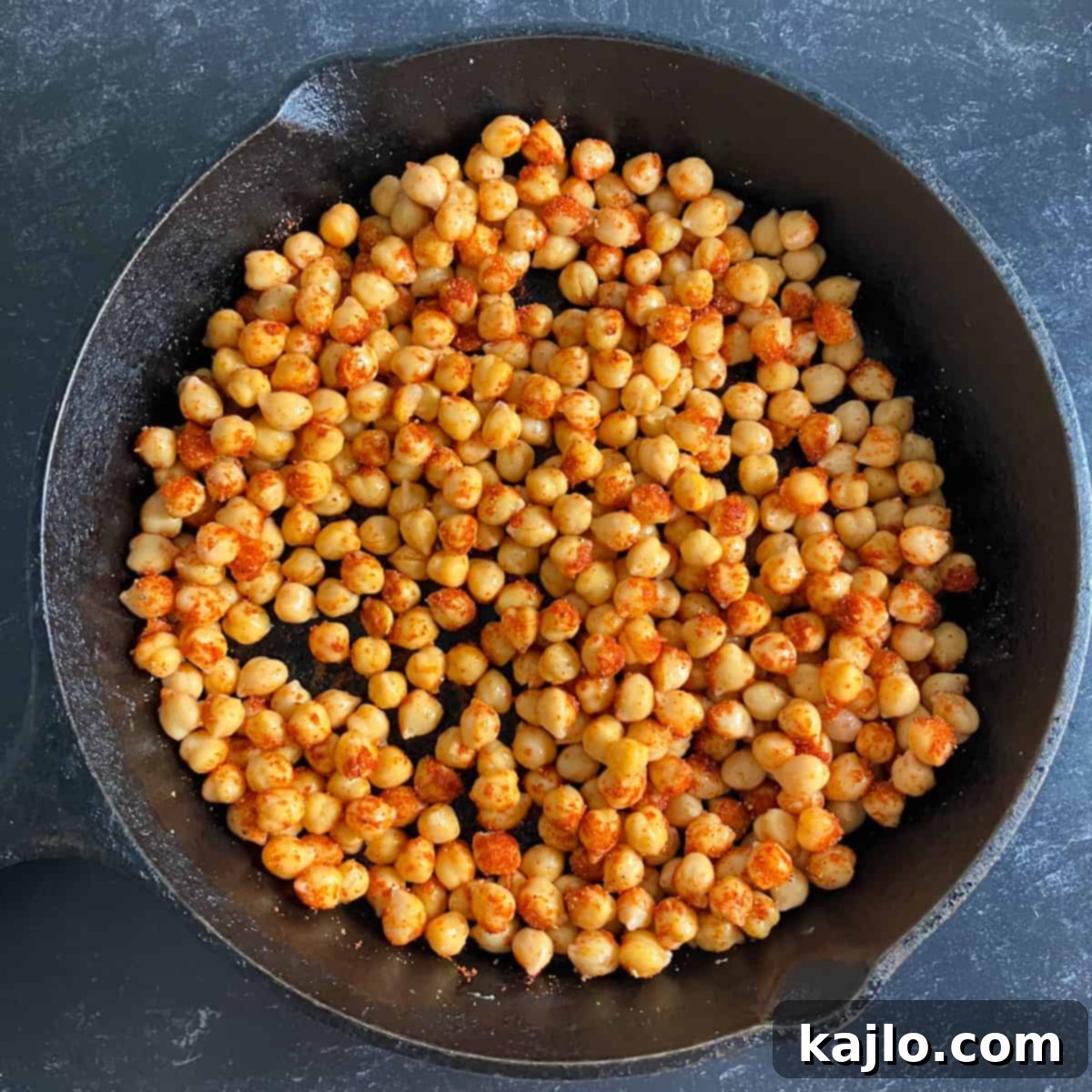
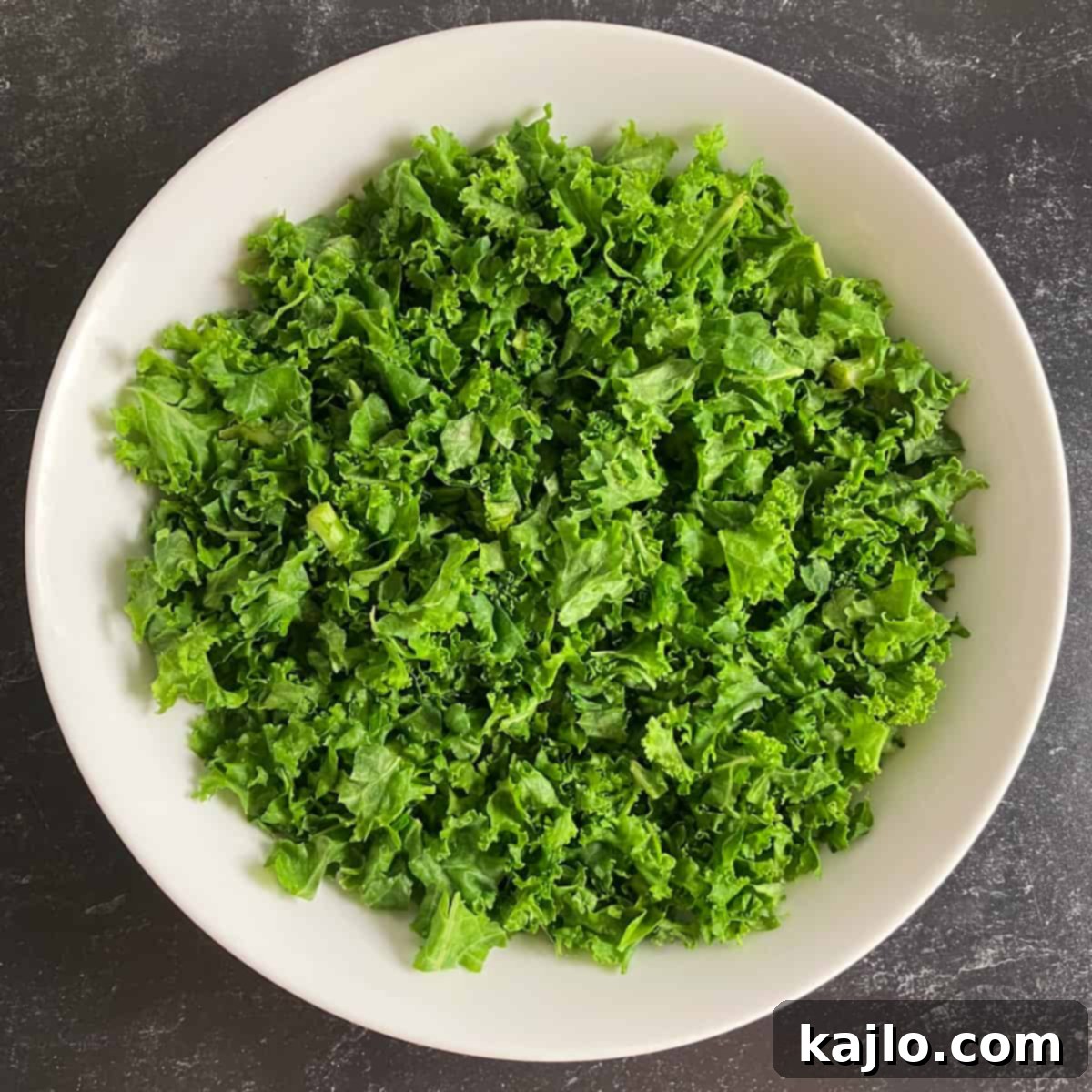
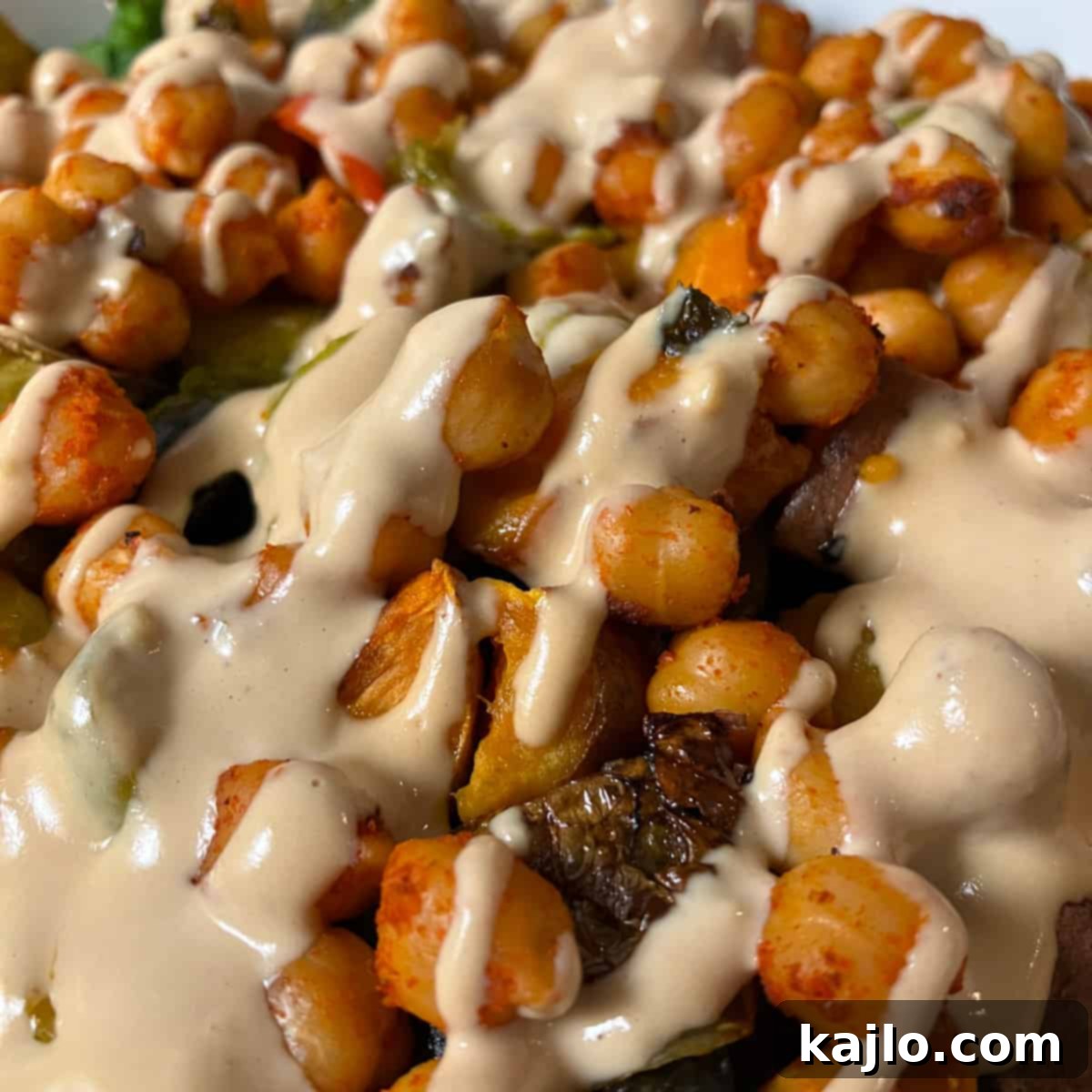
Chef’s Note: I often find myself doubling the dressing recipe because it’s simply that good! While this adds approximately 100 extra calories per serving, the enhanced flavor and creaminess are, in my humble opinion, absolutely worth it!
Feel free to get creative with your roasted vegetables. Hearty root vegetables like carrots and beets can be wonderful substitutes for sweet potatoes and Brussels sprouts, offering unique flavors and colors. Alternatively, for a lighter, seasonal twist, consider making a summer nourish bowl by incorporating softer vegetables such as zucchini and tomatoes. Just keep in mind that these softer varieties will require less roasting time to prevent them from becoming mushy.
How to Store Your Nourish Bowls for Optimal Freshness
These nourish bowls are perfect for meal prepping, allowing you to enjoy healthy meals throughout the week with minimal effort. To store leftover nourish bowls, transfer them to airtight containers and refrigerate for up to 3-4 days. For best results and to maintain texture, we highly recommend storing the dressing and any crunchy toppings (like nuts or seeds) separately until you are ready to serve. This prevents the greens from getting soggy and the toppings from losing their crispness. If you prepare a larger batch than you can consume within 3-4 days, you can freeze individual components (like roasted vegetables and cooked chickpeas) in freezer-safe containers for longer storage. Thaw them overnight in the refrigerator before reheating and assembling a fresh bowl.
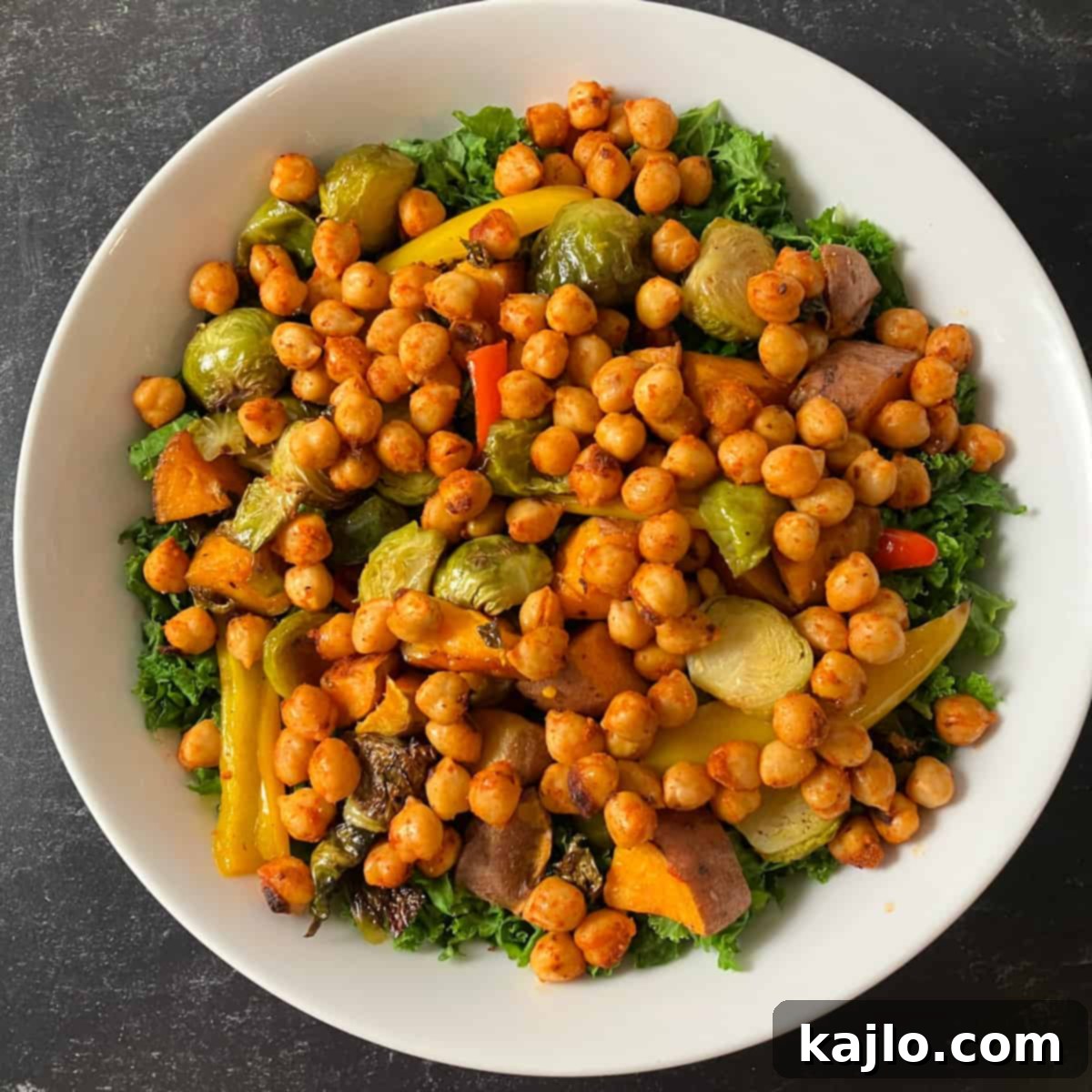
👩🍳 Discover More Nourish Bowl Recipes and Healthy Meal Ideas
If you’ve fallen in love with the concept of nourish bowls and are eager to explore more vibrant, healthy meal options, you’re in luck! We have a fantastic collection of bowl recipes, each packed with nutrient-dense vegetables, protein, and other wholesome ingredients. These recipes are designed to keep your meals exciting and your body nourished:
- Keto Salmon Sushi Bowl: A delightful deconstructed sushi experience, perfect for a low-carb diet.
- Inside Out Egg Roll Recipe: All the flavors of your favorite egg roll, simplified into a convenient bowl.
- Air Fryer Chicken Shawarma Bowls: Flavorful chicken shawarma made easy in your air fryer, served over a fresh base.
- Keto Unstuffed Cabbage Rolls: A comforting, low-carb take on classic cabbage rolls.
- Wildflower Chopped Salad Bowl with Black Beans: A hearty and fresh salad bowl, packed with plant-based goodness.
- Canned Salmon Salad (No Mayo): A light and flavorful salmon salad, perfect for a quick, protein-rich meal.
- Air Fryer Eggplant Parm: Enjoy baked eggplant parmesan bites, delicious served over zucchini noodles or whole grain pasta for a complete bowl meal.
- Healthy Frozen Hash Browns in Air Fryer: Transform these into a wholesome breakfast nourish bowl by adding eggs, avocado, and cooked peppers and onions.
❓ Frequently Asked Questions About Nourish Bowls
We’ve gathered some common questions about nourish bowls to provide you with even more insights into these healthy and versatile meals.
Are nourish bowls truly healthy?
Absolutely! In terms of general nutrition, these nourish bowls are exceptionally healthy. They are thoughtfully crafted with a balance of lean protein, high-fiber components, essential vitamins and minerals, beneficial phytonutrients, and healthy fatty acids. This powerful combination of protein, fiber, and high-volume, non-starchy vegetables works synergistically to keep you feeling full and satisfied on fewer calories, which can be highly beneficial if you have a weight loss goal. They are a fantastic way to increase your vegetable intake and support overall well-being.
How can I make nourish bowls even lower, under 400 calories?
Achieving a nourish bowl under 400 calories is quite simple with a few strategic adjustments. To significantly reduce the calorie count, consider skipping the sweet potatoes entirely and opt for all non-starchy vegetables. Instead of drizzling your roasting veggies with olive oil, use a calorie-controlled cooking spray to minimize added fats. Additionally, reduce the amount of dressing you use. While these adjustments can lower the calorie count, it’s important to remember that consistently undereating nourishing foods can sometimes hinder weight loss progress by potentially leading to overeating later. Always strive for a balanced approach to ensure sustained energy and satiety.
What’s the difference between nourish bowls and Buddha bowls?
The terms “nourish bowl” and “Buddha bowl” are often used interchangeably to describe a healthy, visually appealing meal served in a bowl, typically overflowing with vegetables. Both concepts emphasize a balanced combination of grains, proteins, vegetables, and a flavorful dressing. Historically, Buddha bowls were more strictly vegetarian or vegan, often featuring grains, legumes, and various plant-based components arranged beautifully, said to resemble the rounded belly of Buddha. While nourish bowls also prioritize healthy ingredients, they tend to be a broader category that can include meat or seafood, though many popular nourish bowl recipes, like ours, are indeed plant-based. Essentially, both are fantastic ways to enjoy a wholesome and customizable meal!
Are grain bowls suitable for weight loss?
The suitability of grain bowls for weight loss depends largely on your specific dietary plan and overall calorie intake. If you are following a low-carb diet, grain-based bowls, which typically include ingredients like quinoa, rice, or pasta, may be high in carbohydrates and thus not align with your goals. However, if your weight loss strategy focuses on maintaining a calorie deficit over time, grain bowls can absolutely be enjoyed as part of a healthy diet. Whole grains offer beneficial fiber and nutrients that contribute to satiety. During my own 70-lb permanent weight loss journey, I occasionally incorporated grain bowls with wholesome ingredients, demonstrating that balance and moderation are key to long-term success.
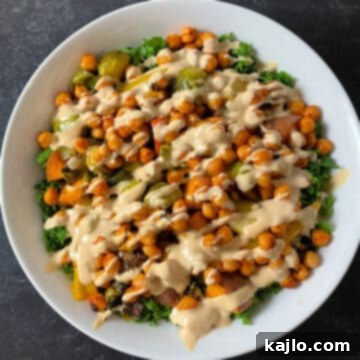
Low Calorie Nourish Bowls with Creamy Tahini Dressing (Vegetarian, Vegan)
Summer Yule
Ingredients
- 2 medium sweet potatoes about 10 ounces or 283 grams
- 1 lb Brussels sprouts 454 grams
- 1 medium red bell pepper
- 1 medium yellow bell pepper
- 1 tablespoon olive oil
- salt and pepper, to taste
- 2 cans chickpeas, drained and rinsed (15½ ounce cans)
- cooking oil spray
- 2 teaspoons smoked paprika
- ½ teaspoon onion powder
- ½ teaspoon garlic powder
- 10 ounces kale leaves
For the nourish bowl dressing:
- ¼ cup tahini
- 3 tablespoons apple cider vinegar
- 2 tablespoons reduced sodium soy sauce
- 1-2 cloves garlic
- 1-2 tablespoons water (if needed)
Instructions
- Preheat the oven to 400°F (200°C) and prepare the veggies. Cut the peppers into thick slices, cube the sweet potatoes (leave the skin on for more fiber), and trim and halve the Brussels sprouts (quarter them if they’re large).
- Drizzle the veggies with oil, season with salt and pepper and roast for 45-60 minutes in a roasting pan or sheet pan about ⅓ down from the top of the oven. Flip and stir the vegetables after the first 30 minutes of cooking time.
- While the veggies cook, prepare the chickpeas. Drain chickpeas and pat them dry with paper towels. Season with smoked paprika, onion powder, garlic powder, salt, and pepper. Spray a cast iron skillet with cooking spray and warm the chickpeas in the skillet for 5-10 minutes over medium heat. Set them aside.
- Remove any thick stems from the kale and tear it into bite-size pieces. Massage the kale leaves in a big bowl for a few minutes with clean hands to make it tender. Set the kale aside.
- To make the nourish bowl dressing, blend the tahini, vinegar, soy sauce, garlic, and water together.* Set it aside.
- How to assemble nourish bowls: Divide the ingredients between four bowls in this order: kale, roasted vegetables, seasoned chickpeas, dressing. Then stir everything together and enjoy!
Equipment
- Knife
- Roasting Pan
- Cast Iron Skillet
- Food Processor or Blender
Notes
💭 Expert Tips from Dietitian Summer Yule
This is a level 1 recipe (may help support fat loss). Eating more veggies is likely a good idea for most people. According to the Dietary Guidelines in the United States, Americans on average aren’t consuming vegetables at the recommended levels. This is true across all age groups.
In addition, these homemade nourish bowls help you cut back on ultra-processed foods, something many of us overconsume. If you’re feeding the family, I highly recommend doubling the sauce (I usually do this). This makes the meal about 600 calories. Consider adding some grains too if you are feeding high energy eaters (such as teenagers).
If you are seeking a bit more dietary balance in your life, I hope you enjoy this meal. The colorful phytonutrients are a feast for the eyes and may benefit your health if you eat your veggies often. These DIY nourish bowls are definitely something I’d consider a feel good food!
Nutrition information is for one serving of the recipe.
nutrition info disclaimer
All recipes on this website may or may not be appropriate for you, depending on your medical needs and personal preferences. Consult with a registered dietitian or your physician if you need help determining the dietary pattern that may be best for you.
The nutrition information is an estimate provided as a courtesy. It will differ depending on the specific brands and ingredients that you use. Calorie information on food labels may be inaccurate, so please don’t sweat the numbers too much.
“To taste” means to your preferences, which may have to be visual to follow food safety rules. Please don’t eat undercooked food x
Nutrition
Join our community! Subscribe for all of the latest and greatest recipes, and follow me on Facebook, Pinterest, Instagram, and YouTube!
